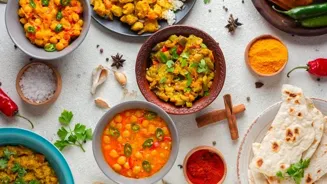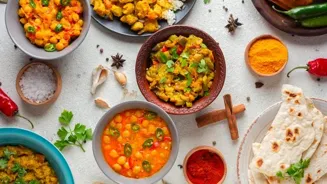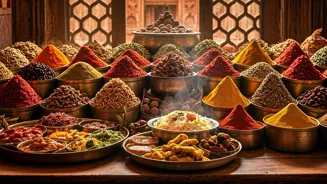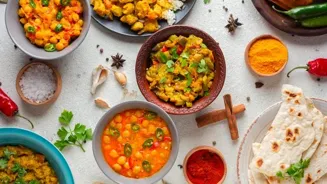Unleash the flavors of Indian cuisine! Master 7 essential cooking techniques for beginners. Dive into the world of vibrant spices and aromatic dishes. Don't miss this culinary journey!
Namaste, food lovers!
Ever dreamt of whipping up a delicious daal or a flavourful vegetable curry that tastes just like your favourite restaurant? Indian cuisine, with its vibrant spices and diverse flavours, can seem intimidating at first. But fear not!
With a little guidance and these seven essential cooking techniques, you'll be creating authentic Indian dishes in your own kitchen in no time. Get ready to embark on a culinary journey that will tantalize your taste buds and impress your friends and family.
Let's unlock the secrets to mastering the art of Indian cooking!
Tadka: The Aromatic Tempering
Tadka, also known as tempering, is the soul of many Indian dishes. It involves heating oil or ghee (clarified butter) and then adding whole spices like cumin seeds, mustard seeds, dried red chilies, and asafoetida (hing).
The hot oil infuses the spices, releasing their aromatic oils and creating a flavour bomb that is then poured over or mixed into the main dish. The crackling of the mustard seeds and the fragrant aroma are classic indicators that your tadka is ready.
This technique is commonly used to enhance the flavour of daals, sambhar, chutneys, and even some vegetable preparations. Ensure your spice levels are correct, so as to ensure that your dish is not too spicy, as it will ruin the underlying ingredients.
A pro tip for a perfect tadka is to use good quality ghee or oil. Ghee adds a rich, nutty flavour, while a neutral oil like vegetable oil works well for those who prefer a lighter taste. Be careful not to burn the spices, as this will result in a bitter taste.
The key is to heat the oil on medium heat and add the spices in the correct order, starting with the ones that take the longest to release their flavour. For example, mustard seeds usually go in first, followed by cumin seeds, and then the other spices.
Once the spices start to crackle and release their aroma, immediately pour the tadka over your dish or mix it in. Remember, practice makes perfect, so don't be discouraged if your first tadka isn't perfect. With a few tries, you'll be a tadka master in no time!
Another thing that will make this cooking technique easier, is to ensure that the heat is kept in medium or a slight degree lower. If your heat is too high, the ingredients will burn, and the flavour of your recipe will be bitter.
Bhuna: Sautéing for Depth of Flavour
Bhuna is a technique that involves sautéing ingredients, usually onions, ginger, garlic, and spices, in oil or ghee over medium heat until they are well browned and the raw smell disappears. This process helps to develop deeper, more complex flavours in the dish.
The caramelisation of the onions and the release of the essential oils from the spices create a rich base that forms the foundation of many Indian curries. The key to a good bhuna is patience and constant stirring to prevent the ingredients from burning.
It is crucial for an excellent cooking experience.
To achieve the perfect bhuna, start by heating the oil or ghee in a pan. Add finely chopped onions and sauté them until they turn golden brown. This may take some time, but it's important to be patient and allow the onions to caramelise properly.
Once the onions are browned, add ginger-garlic paste and sauté for another minute until the raw smell disappears. Then, add your spices, such as turmeric powder, coriander powder, cumin powder, and red chili powder.
Sauté the spices for a few minutes, stirring constantly, until they release their aroma. Be careful not to burn the spices, as this will ruin the dish. If the mixture starts to stick to the pan, add a splash of water to deglaze it.
Continue sautéing until the oil separates from the mixture and the ingredients are well browned. This process can take anywhere from 10 to 15 minutes. Once the bhuna is ready, you can add your vegetables or other ingredients and continue cooking.
Dum: Slow Cooking for Infusion
Dum cooking is a slow cooking technique where food is cooked in a sealed container over low heat. This method allows the flavours and aromas to meld together beautifully, resulting in a dish that is incredibly flavourful and aromatic.
The sealed container traps the steam, which helps to cook the food evenly and prevents it from drying out. Dum cooking is often used for biryanis, pulaos, and other rice dishes, as well as for certain types of curries and vegetables. The cooking process should be thoroughly monitored.
To perform dum cooking, the first step would be to choose a suitable vessel. Traditionally, a heavy-bottomed pot or a handi is used. The food is placed in the pot, and the lid is sealed tightly with either a dough made of flour and water or a damp cloth.
The pot is then placed over low heat, and the food is cooked slowly for several hours. The duration of cooking depends on the dish and the ingredients used. It is important to maintain a low and steady heat to prevent the food from burning.
During the cooking process, the steam generated inside the pot helps to cook the food evenly and infuses it with flavour. The sealed environment also prevents the loss of moisture, resulting in a dish that is moist and tender.
Once the cooking is complete, the pot is allowed to rest for a few minutes before opening the lid. This allows the flavours to settle and the steam to escape gradually. Dum cooking is a time-consuming process, but the results are well worth the effort.
The slow cooking and the sealed environment create a dish that is incredibly flavourful, aromatic, and tender.
Roasting Spices: Enhancing Aromatic Intensity
Roasting spices before grinding them is a common practice in Indian cooking. Roasting helps to release the essential oils in the spices, intensifying their flavour and aroma. This technique is particularly useful for whole spices like coriander seeds, cumin seeds, and dried red chilies.
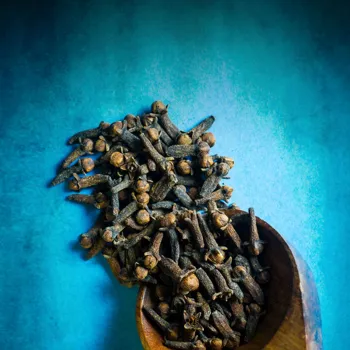
Roasted spices add a depth of flavour to curries, daals, and other Indian dishes. It gives it a stronger, much more distinctive edge that one doesn't get from any other dishes.
To roast spices, heat a dry pan over medium heat.
Add the spices and roast them for a few minutes, stirring constantly, until they become fragrant and slightly darkened in colour. Be careful not to burn the spices, as this will result in a bitter taste. Once the spices are roasted, remove them from the pan and allow them to cool completely.
Then, grind them into a fine powder using a spice grinder or a mortar and pestle. Store the ground spices in an airtight container in a cool, dark place. Roasted and ground spices have a much more intense flavour than pre-ground spices, so you may need to use less of them in your recipes.
Experiment with different roasting times and spice combinations to create your own unique blends.
Garam Masala: The Quintessential Spice Blend
Garam masala is a blend of ground spices that is commonly used in Indian cooking. There are several recipes readily available online that can be reviewed.
The spices used in garam masala vary from region to region and even from family to family, but some common ingredients include cardamom, cinnamon, cloves, cumin, coriander, and black peppercorns.
Garam masala is typically added towards the end of the cooking process to enhance the flavour and aroma of the dish. This can make or break your creation.
To make your own garam masala, start by toasting the whole spices in a dry pan over medium heat until they become fragrant.
Allow the spices to cool completely, and then grind them into a fine powder using a spice grinder or a mortar and pestle. Store the garam masala in an airtight container in a cool, dark place. You can also buy pre-made garam masala from most grocery stores.
However, making your own garam masala allows you to control the ingredients and adjust the flavour to your liking. Experiment with different spice combinations to create your own signature blend.
Garam masala is a versatile spice blend that can be used in a wide variety of Indian dishes, from curries and daals to vegetables and rice. A small pinch of garam masala can add a burst of flavour and aroma to any dish.
Understanding Spice Combinations: The Key to Flavour
Indian cuisine is all about the art of blending spices to create unique and complex flavour profiles. Understanding how different spices complement each other is essential for mastering Indian cooking.
Some common spice combinations include turmeric and cumin, coriander and chili powder, and ginger and garlic. Experiment with different combinations to discover your own favourite flavour combinations. Researching the best combinations will definitely help.
Each spice plays a unique role in the overall flavour of the dish. Turmeric, for example, adds a warm, earthy flavour and a vibrant yellow colour. Cumin adds a smoky, earthy flavour with a slightly bitter note.
Coriander adds a bright, citrusy flavour, while chili powder adds heat and a touch of smokiness. Ginger adds a pungent, spicy flavour, while garlic adds a strong, savoury flavour.
By understanding the individual characteristics of each spice, you can create flavour combinations that are balanced and harmonious. Remember, practice makes perfect, so don't be afraid to experiment with different spice combinations until you find what works best for you.
Mastering the Art of Roti Making
Roti, also known as chapati, is a staple in Indian cuisine. It is a flatbread made from whole wheat flour and water. Making roti at home can seem daunting at first, but with a little practice, you'll be making soft, fluffy rotis in no time.
Roti is a versatile bread that can be served with curries, daals, vegetables, or even just plain with some butter or ghee. This is why it is important that it has the right texture and taste.
To make roti, start by mixing whole wheat flour and water in a bowl to form a soft dough.
Knead the dough for about 5-10 minutes until it becomes smooth and elastic. Divide the dough into small balls and roll each ball into a thin circle using a rolling pin. Heat a griddle or tawa over medium heat.
Place the roti on the hot griddle and cook for a few seconds on each side until small bubbles start to appear. Then, flip the roti and cook for another few seconds until it starts to puff up.
Finally, remove the roti from the griddle and hold it directly over an open flame for a few seconds until it puffs up completely. This step is optional, but it gives the roti a nice smoky flavour and a soft texture. Serve the roti hot with your favourite Indian dishes.
With a little practice, you'll be able to make perfect rotis every time!
AI Generated Content. Glance/InMobi shall have no liability for the content



